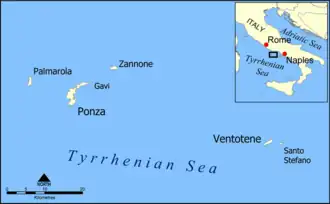Santo Stefano Island

%252C_00.jpg)
Santo Stefano (Italian: Isola di Santo Stefano) is an island in the Tyrrhenian Sea off the west coast of Italy, and part of the Pontine Islands. It is roughly circular, with a diameter of less than 400 metres (1,300 feet), and it is located 2 kilometres (1+1⁄4 miles) east of the nearby island of Ventotene. From 1797 to 1965, it was the site of the Santo Stefano Prison.
Overview
Like the rest of the archipelago, the island was created by volcanic activity.
The island has been uninhabited since the closure of the prison, except for tourists making day trips.
The island has had several names, such as Partenope, Palmosa, Dommo Stephane and Borca since Roman times.
The island, which is partly privately owned, was put up for sale in 2012 for €20,000,000.[1] This did not include the prison, which belongs to the Italian state.
On 26 July 2021, the European Observer reported that a refurbishment project was to be announced to turn the island into a European think-tank, academy and open-air museum as part of a European integration project.[2] In March 2025, an exhibit on the history of the prison and on the plans for renovation was announced for September 2025. A government official announced that "21 cultural institutions and universities have signed agreements to produce content and organize cultural initiatives on Santo Stefano".[3]
Wildlife
This island once harbored an endemic lizard, the Santo Stefano lizard (Podarcis sicula sanctistephani). It became extinct in 1965, probably due to feral cats and a snake species.[4]
Santo Stefano Prison
The island is dominated by the Santo Stefano Prison built by the Bourbons, completed in 1797. It is a three-story building in a horseshoe configuration. The tower in the middle is not a watchtower, but a chapel, so inmates could observe the celebration of mass.[5]: 85–89 [6]
It originally had 99 cells, each four metres by four metres and accommodating four inmates. The cell size was later halved to double the number of cells. Built for 600 inmates, it had 800 in 1817 (and 400 on Ventotene).
The prison's design is based on Jeremy Bentham's Panopticon, which allows all prison cells to be observed by a single unseen guard, who may or may not be present, giving them the sensation of being constantly watched.
In October 1860, part of the Bourbon troops left the island for the siege of Gaeta. During a revolt, some Camorra prisoners proclaimed the Republic of Santo Stefano. The prisoners legislated a statute and remained autonomous until January 1861, when a Navy contingent recovered the island.
Many famous political prisoners have been incarcerated here, including Carmine Crocco, the most important brigand during Italian unification, and Gaetano Bresci, the anarchist who assassinated King Umberto I in 1900 and was imprisoned for a year before being hanged in his cell by his jailers. During the Fascist regime, many antifascists were imprisoned here, including Sandro Pertini, later the President of Italy, Umberto Terracini, Giorgio Amendola, Lelio Basso, Mauro Scoccimarro, Giuseppe Romita, Altiero Spinelli and Ernesto Rossi.
The prison was closed in 1965.[5]: 91
See also
References
- ^ rightmove.co.uk
- ^ 'Prison island' birthplace of EU reborn as think-tank venue
- ^ "Macioce annuncia per Settembre la prima mostra del futuro museo di Santo Stefano". Associazione per Santo Stefano in Ventotene (in Italian). 2025-03-09. Retrieved 2025-07-29.
- ^ David Day, 1981, The Doomsday Book of Animals, Ebury Press, London.
- ^ a b De Rossi, Giovanni Maria (1995). Ventotene e S. Stefano (English transalation). Translated by Wright, Nicole Jane. Rome, Italy: Guido Guidotti Editore.
- ^ "Carcere di Santo Stefano". Italian Wikipedia (in Italian). Retrieved 29 February 2020.
External links
 Media related to Santo Stefano (island) at Wikimedia Commons
Media related to Santo Stefano (island) at Wikimedia Commons